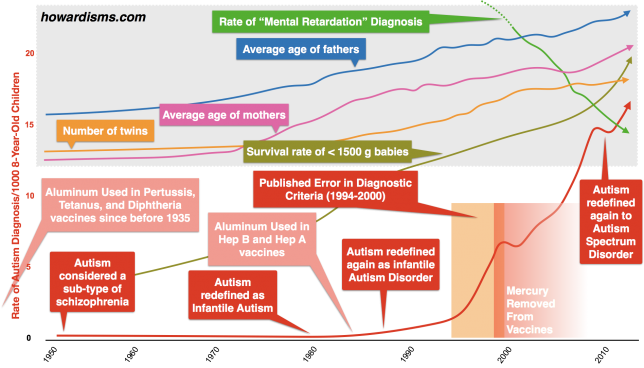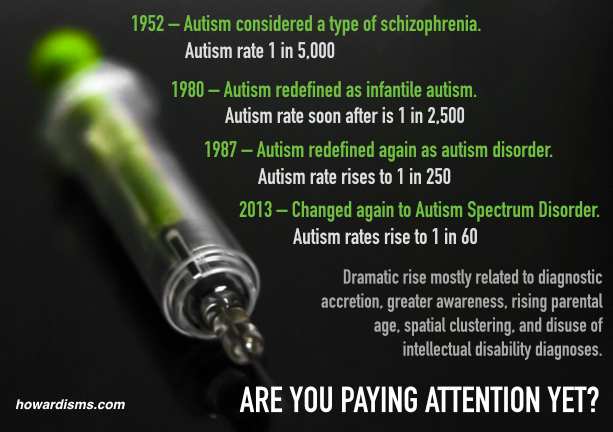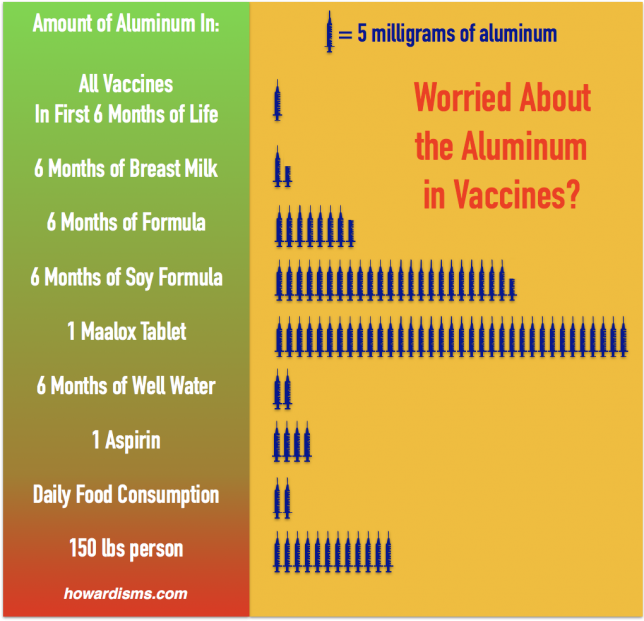I wrote a short piece recently about the safety and efficacy of vaccines that has now been read almost half a million times. Hundreds of messages, comments, and emails later, I’ve learned that I am both the best thing since sliced bread and also a horrible human being who will rot in hell. I was also asked repeatedly to do some things to myself that I’m pretty sure are anatomically impossible.
In any event, let me summarize in one sentence the only argument that matters about vaccines and autism: since the rate of autism is the same among children who have been vaccinated as it is among children who have not been vaccinated, then there is no need to look into what ingredient in vaccines cause autism since vaccines as a whole do not. That’s it. That’s the whole ball of wax (or vax?). Unless someone first refutes droves of data which state that the rates of autism are unaffected by vaccination status, then please don’t read anything else that person has to offer.
Nevertheless, one question has come up over and over again, mainly because of J.B. Handley’s recent Facebook ad campaign. Handley has been buying readers for an article that claims that aluminum in vaccines causes autism. Handley recently bragged that over 400,000 folks had read his article; it costs an average of 62 cents to get a click from a Facebook ad, so that amounts to potentially around $250,000 spent by his group to promote this false narrative.
Over and over again, people have said that I explained away everything but aluminum. In fact, the mysterious promoter of the website vaccinepapers.org (hmm… I wonder what famous antivaxxer runs this well-funded site?) emailed me this morning and had this to say:
Most of your content is reasonable and scientifically accurate enough. For example I agree that formaldehyde in vaccines is not a safety concern. […]
However, there are two critical issues that have come up in the scientific literature recently that are not addressed on your blog: immune activation-mediated brain injury, and the unique toxicity and kinetics of aluminum adjuvant.
These issues are closely linked, because the aluminum adjuvant in vaccines can cause inflammation in the brain, and by this mechanism cause life-long neuro and psychiatric disorders.
Autism is caused by neuroinflammation during early brain development, and aluminum adjuvant causes the specific type of neuroinflammation that is responsible (IL-6 and IL-17).
And that is an excellent summary of the aluminum theory, which has supplanted the formaldehyde theory and the too many antigens theory and the mercury theory and the thimerosal theory. The theories keep changing, but the fundamental issue is never addressed: autism isn’t more common among vaccinated children! Since there are hundreds of ingredients in vaccines, the theories can conveniently morph from one thing to the next, but the only thing that matters is whether or not autism is more common in vaccinated children.
The crux of the anti-vax argument is that there is an epidemic of autism and that the only thing that could have caused this epidemic are vaccines. Let’s briefly talk about that point before we get to aluminum in particular.
Let me explain a few things about this graphic.
First, the red line represents the rate of diagnosis of autism between 1950 and 2015. Note that ‘diagnosis of autism’ is not the same thing as autism; diseases are at any given time either under-diagnosed or over-diagnosed and diagnostic criteria change.
- Donald Triplett was the first person diagnosed with autism, in 1938. This doesn’t mean he was the first person with autism, just the first person diagnosed with it. He is still alive today and has lived a relatively normal, albeit eccentric, life.
- In the early days, it took a long time for the diagnosis of autism to become popular, and in the early 1950s, autism was considered a sub-type of schizophrenia. For a long time, it was also considered the result of bad parenting, and parents resisted the diagnosis.
- Infantile autism was separated out from schizophrenia in 1980 but the diagnostic criteria were vague. A “pervasive” disorder was required, and this was very subjective. This was the first time that autism was included in the DSM manual (DSM III). Even after this, most children still went undiagnosed. If they had intellectual disabilities, they were labeled as mentally retarded. If they didn’t, they were just odd. Other children were labeled as having specific disabilities, like speech and learning disorders, or other developmental disorders. Children were labeled as spastic or were thought to have Rett syndrome or other once popular diagnoses. Asperger Syndrome described many of these children and was still separate from Autism. Overall and importantly, around 2% of children before 1950 were labeled with one of these diagnoses.
- In 1987, the term Autism Disorder was defined with a checklist of features in the DSM-III-R manual, and this led to many children being diagnosed with autism according to the new criteria. Only 8 of 16 criteria were necessary (all criteria had been required before) and the age of potential diagnosis was lowered. Much of the stigma previously associated with autism (because of its association with schizophrenia and bad parenting) was gone, and, at the same time, terms like mental retardation became increasingly unpopular. With a redefinition and clarification of the term ‘Autism Disorder,’ the rate of diagnosis rose significantly.
- In 1994, another revision of the criteria was made for the DSM-IV and some unintentional typographical errors contributed to overdiagnosis of pervasive development disorders (PDD) (for example, an and was mistakenly changed to an or making it easier to satisfy required criteria) and also for Asperger Syndrome. These changes, intentional and unintentional, made it even easier to diagnosis Autism and increased the false positive rate of diagnosis. These mistakes were not corrected until 2000 when the DSM-IV-R was published. Rates of diagnosis of autism soared in this period.
- In 2000, with the publication of DSM-IV-R, the rates of diagnosis briefly declined, but with changes in Asperger criteria (now a part of Autism), rates of diagnosis continued to go up.
- After a period of stability in diagnosis, in 2013 the definition was changed again to Autism Spectrum Disorder which wrapped into autism a number of diagnoses that had previously been independent. Once again, rates rose dramatically.
More liberal diagnostic criteria combined with a heightened interest in autism accounts for most of the rise in autism diagnosis (availability bias). A comparison of diagnostic criteria from 1980 to the criteria today is dramatic. But there are other things to note in the graphic as well.
The declining green line at the top of the graphic reflects the drop in the diagnosis of “mental retardation” over the last 40 years. In fact, there has been a greater drop in the number of children labeled as having mental retardation than there has been an increase in the number of children who are labeled as having autism. If one didn’t know any better, one would assume that we “cured” mental retardation while autism simultaneously and proportionately came out of nowhere.
This transposition in diagnoses happened at a time when we would have expected the rates of autism (as currently defined) to be rising independently. We know that autism is definitively and independently associated with the following factors:
- Twins and higher order multiple pregnancies
- Older maternal age
- Older paternal age
- And birth before 26 weeks or very low birth weight (less than 1500 g)
The graphic also demonstrates the relative increases of each of these categories in the last 40 years. In fact, the survival rate of very low birth weight children has increased from only about 20% to almost 80%, while things like in vitro fertilization have dramatically increased the number of children born to twin or triplet pregnancies. Social changes have increased the average age of mothers and fathers to historic highs, both of which are associated with increased rates of autism.
Honest scientists are not surprised by the rates of autism, and they don’t believe in an “autism epidemic.” (Here is an article discussing some of the reasons why autism rates are increasing.) Many anti-vaxxers also claim that there are no adults with autism in America, arguing in essence that this is the first generation of children to suffer from the condition. But the rate of adult autism in the US is around 1.1%. While this rate is lower than the 1.6% seen today in children, we have to consider several things: autism is likely underdiagnosed in adults (who aren’t being seen by pediatricians versed in modern, more relaxed guidelines); autism is likely overdiagnosed in children (who are getting too much attention from those same pediatricians); autism in adults likely looks quite a bit different than it does in children and many children diagnosed at a young age with it today will likely not be considered autistic as they age; and, lastly, the rates of autism likely are higher in children than in adults due to the factors just discussed. Thus, I would consider the difference in 1.1% in adults and 1.6% in children meaningless and not evidence of a new epidemic of autism.
But what about aluminum?!
Okay, I’ll discuss this even though there is no reason to do so. Roughly 2% of children have been in the domain of autism/developmental disorder/learning disability/etc. for the last hundred years. If anything, at a time when rates should be increasing, the overall rates are staying the same! That’s progress! But what about aluminum?!
Let’s look at the graph one more time (I did spend hours making, it so…):
There are a couple of other things to notice on this graphic. First, notice that even after mercury was removed from vaccines, autism rates continued to grow. In fact, there was a higher increased rate of diagnosis of autism after mercury was removed than before. If you believe that correlation equals causation, then you should argue that mercury was protective against autism and we should put it back in vaccines! Still, mercury isn’t aluminum. It isn’t. But this fact does speak to the credibility of those who claim that aluminum is associated with autism because before those folks claimed that aluminum was the cause of autism, they were absolutely, positively, 100% certain that the cause was mercury. They were wrong then, and they are wrong now because they haven’t changed their underlying incorrect assumptions and misuse of science.
But let me point out something else: aluminum as an adjuvant has been in vaccines for decades! Almost every person born after 1935 has had aluminum adjuvants in their vaccines. It is nothing new. If aluminum adjuvants were associated with autism, we should have seen a slow and gradual increase in the rates of autism through the 1950s, 1960s, and 1970s as the adoption of vaccines with aluminum adjuvants improved in the US. But we didn’t see that. Instead, we saw changes in the rates of autism after the diagnostic criteria were changed (by the way, we have seen the same thing with rates of diabetes and hypertension and a myriad of other diseases that have mutable diagnostic criteria).
We should have seen a spike in the rates of neurologic problems among people receiving aluminum adjuvants in the Hepatitis B and Hepatitis A vaccines after 1984, but we did not. Aluminum isn’t new; it’s been around in injected vaccines for over 80 years!
After mercury failed to be the culprit anti-vaxxers sought, they moved on to many other things (read this article too), but after touting the evils of mercury as a toxic heavy metal like lead, aluminum seemed a natural, scary choice. It had been previously implicated as the cause of Alzheimer’s in the 1980s (and later proven to be unrelated to Alzheimer’s). But aluminum is not a heavy metal. It is a very abundant and non-toxic salt as it exists in our bodies. Take a look at this:
A baby gets more aluminum from breastfeeding in the first six months of life than from vaccines, and formula feeding exposes a child to over eight times as much aluminum! I should point out that autism is more common among breastfed children than among bottle-fed children. Do I believe that breastfeeding increases the risk of autism? Of course not. But there is more scientific evidence supporting that fallacy than that autism is associated with aluminum. The average person eats twice the amount of aluminum every day as a baby receives in 6 months; and, watch out if you eat a Maalox tablet while pregnant: you’ll be exposing your child to over 35 times the amount of aluminum as she would get in the first six month’s worth of vaccines.
But what about those studies I read about on Facebook? And ingestion just isn’t the same as injection! I won’t go through all of that here; the work has been done elsewhere. Some of those studies have been retracted already. Most are bad science (really, really bad). Since I’m not going to get down in the weeds over trying to disprove an absurdity, here are some people who have:
- Aluminum Adjuvants in Vaccines and the Blood-Brain Barrier
- Vaccines Don’t Cause Autism
- CHOP: Aluminum
Move over, Christopher Shaw, there’s a new antivaccine scientist in town



